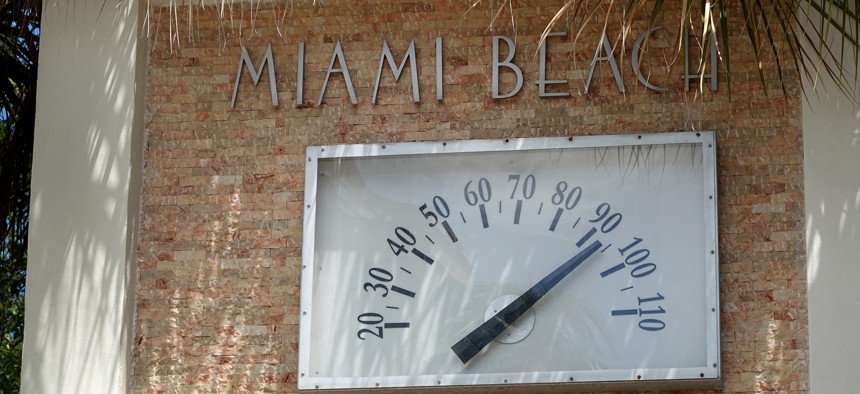Miami-Dade Debuts Plan to Tackle Extreme Heat Problem

A thermometer registers over 90 degrees on Aug. 16, 2022 in Miami Beach. Miami-Dade County could see some of the most extreme change in heat waves in the coming years. Photo by Joe Raedle/Getty Images
The Florida county, which has the most days of extreme heat in the nation, will, among other things, plant more trees and install cool pavement.
As the saying attributed to Mark Twain goes, “Everybody talks about the weather, but nobody does anything about it.” Now public officials in urban heat-stricken areas such as Miami-Dade are at least trying to do something for their sweltering constituents.
Miami-Dade County Mayor Daniella Levine Cava, along with the Resilient305 partnership and the Miami Foundation, recently announced the launch of the county’s Extreme Heat Action Plan, the first in the county’s history.
The plan seeks to mitigate the effects of extreme heat through education, improved cooling options, and a combination of blue, green, and gray infrastructure to cool neighborhoods and communities. Miami-Dade has the most days of extreme heat in the nation, defined as “a period of high heat and humidity with temperatures above 90 degrees for at least two to three days.”
“We need to have lighter building materials and develop as a city that can address the heat,” Miami-Dade Chief Heat Officer Jane Gilbert says. “We need to reduce the waste heat from buildings and cars.”
Adds Levine Cava: “We want people to take actions to protect themselves from the heat. People need to be prepared,” mentioning in particular those who work outside much of the day and often get dehydrated—sometimes without realizing it.
Known for Hurricanes, Miami-Dade Is Actually More Susceptible to Heat.
Miami-Dade is known for its vulnerability to hurricanes, but extreme heat causes more deaths and has a greater annual economic impact than any other weather-related disaster.
Each year, extreme heat kills about 34 people in Miami-Dade County, records show. It also creates economic losses estimated at $10 billion annually because of lost worker productivity. And due to longer and hotter summers, heat-related illnesses are on the rise, Gilbert says.
As usual, the poorest residents have it the hardest, the report says: “Numerous studies confirmed the relationship between poverty and heat-associated mortality. People with fewer financial resources are less likely to have access to adequate cooling, more likely to struggle to pay for air conditioning, and are also more prone to not having health insurance.”
Related story – Can Jane Gilbert beat the heat and save lives in South Florida?
One way officials plan to educate the public is to name extreme heat waves in the way hurricanes are named. Also, the county has begun retrofitting virtually all public housing units with efficient air conditioning and is working to expand the tree canopy, which is currently at 20 percent, to 30 percent by 2030. They’re looking into grant funding to help.
In 2017, for example, Hurricane Irma caused the loss of thousands of trees, which cool with their shade, help in absorbing stormwater and clean the air.
“Our goals with this plan are to collectively inform and protect people, make it easier for our residents to cool their homes affordably and to cool our neighborhood, especially with trees where we need them the most. Now is the time to put ambition into action,” Levine Cava says.
Tree Giveaways, Cool Pavements Are Part of Plans to Lower Temperatures.
She goes on, “We have given away 10,000 trees … and are encouraging more people to plant trees. … We are targeting lower income areas that don’t have as many trees.”
Another idea: Conducting pilot programs of different types of cool pavements on walkways, bike paths, parking lots and low-volume roads, while working with the Federal Highway Administration and Florida Department of Transportation (FDOT) on similar pilots for higher-trafficked roads. In Miami-Dade County, as in many U.S. cities, pavements represent the largest percentage of the community’s land cover.
Cool pavement can be permeable, meaning water and water vapor can go through it to keep it cooler, or it could be more reflective than standard pavement, reducing reflected sunshine that heats the air, Gilbert explains.
It's past time to try new ways of tackling old problems, Levine Cava says: “Now is the time to put ambition into action.”
David Volz has been a reporter for numerous community news publications throughout South Florida over the past two decades, as well as the South Florida Sun-Sentinel, Miami Herald and South Florida Business Journal. He covers local government, schools, sports, culture, faith groups and workplaces.
NEXT STORY: Housing Programs Nationwide See Big Infusion of Earmark Cash





